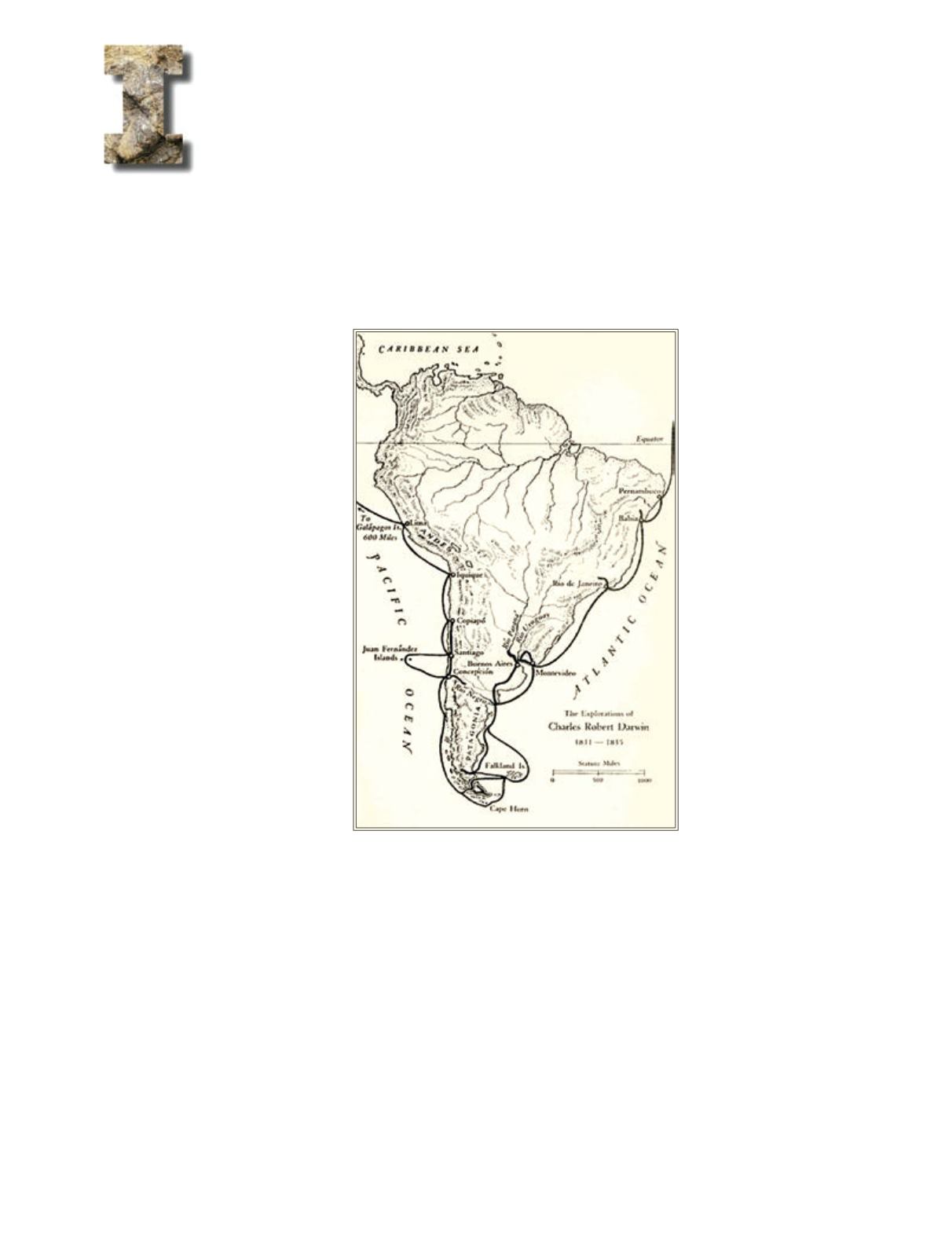
28
Captain FitzRoy took Darwin on the
Beagle
crew as a
gentleman with whom he could talk about science while
sharing meals in his cabin. The ensuing voyage around
the globe and the resulting theory of evolution changed
the world. The rest is history. But an important discovery
that eluded Darwin due to limitations in resources and
manpower in the mid-1830s was one that fascinated
me. Darwin’s initial path eventually led – more than 150
years later – to the unearthing of the most comprehen-
sive giant titanosaur fossils on record.
Dinosaurs have excited scientists – all mankind, really
– for centuries. Imagine a
carnivore with 62 serrated
teeth, six inches long in a
head seven feet long, pursu-
ing mammalian flesh. Picture
an enormous plant-eating,
lizard-like sauropod, 80-
plus feet long, weighing 20
tons and devouring every
bit of vegetation in sight.
These were the fellows who
roamed the world for more
than 150 million years. Our
Homo sapiens existence, as
we know it, has lasted ap-
proximately three million
years, and the only real
knowledge we have on the
subject of human existence,
but for pictographs, is 5,000
years old. We should be very
thankful for the extinctions of
certain animal forms, which,
in all likelihood, would have
by now gobbled us up or
slapped us to death with one
swish of a mammoth tail.
I confess an abiding interest
in finding dinosaur bones
as a hobby. I learned early on that one risks life and limb
by seeking – and finding – old bones. Nations contest
for such fossilized relics, just as bone hunters of the Wild
West in the late 1800s clashed during the Bone Wars. In
2012, an auction of an 80-percent-complete articulated
tarbosaur, a T-Rex-type, brought Mongolia and the United
States into play, involving the Customs Department, the
Justice Department, and the Bureau of Homeland Security.
I know; I was the winning bidder at the auction, trying to
get the bones to the Peabody Museum at Yale University.
I almost got thrown out of the Society of Vertebrate Pale-
ontology for it, as the Society didn’t know I was bidding
for the Peabody Museum, but I happily remain a member
in good standing. The prior largest auction ever brought
more than $8 million for a T-Rex, proving that bones
invoke more than scientific interest alone.
n 1984, as the 150th anniversary of Charles Darwin’s
journey to South America approached, a Chilean
friend and world-class sailor, Augustin Edwards,
invited me to be the navigator and geologist on a sail-
ing adventure following Darwin’s landfalls on the Chilean
coast. He said the BBC was planning a documentary, re-
tracing the voyage of the
HMS Beagle
. Edwards was making
replica ship’s boats and a replica of the 380-ton
Adventure
,
which accompanied the
Beagle
and was used to help sur-
vey the Argentine coast around Cape Horn and up the
coast of Chile into the Pacific. I jumped at the invitation.
My qualifications for
the journey were sparse.
I served as the assistant
navigator and the com-
munications officer on a
destroyer in the Vietnam
War and I had taken one
geology course at Hamilton
College my freshman year,
before transferring to Yale.
The choice of studying
geology was easy because
I was fascinated by how riv-
ers found channels through
solid rock, a phenomenon I
witnessed on several camp-
ing and canoeing trips of
over 100 miles on the Dela-
ware River as a lad. While
fishing, one is able to ob-
serve the natural world and
imagine how rocks, sedi-
mentary or metamorphic,
are bent by the stresses
of the mantle as it warps,
driven by the Earth’s plates
as they change position. I
could get lost in the ions of
time, having been shown
by my mother the trilobites and critters in rocks cut by
streams in Upstate New York.
So, with the offer in mind, I was off to the library to read
about the 21-year-old Darwin’s trip to South America as
a naturalist aboard the
HMS Beagle
, under the command
of 29-year-old Captain Robert FitzRoy. Darwin had little
training as a naturalist. He had collected beetles. He had
only gone to the mountains in Wales to “geologize” with
Adam Sedgwick, a professor of geology at Cambridge. He
had little knowledge of fossils, but there was a dearth of
fossil finds to compare at that time. He luckily had some-
how obtained a copy of Charles Lyell’s
Principles of Geology
in his kit. It is believed that his study of geology by read-
ing Lyell’s books and applying practical principles when
he saw oyster shells on top of mountains led him to con-
clusions that helped convince him of evolutionary theory.


